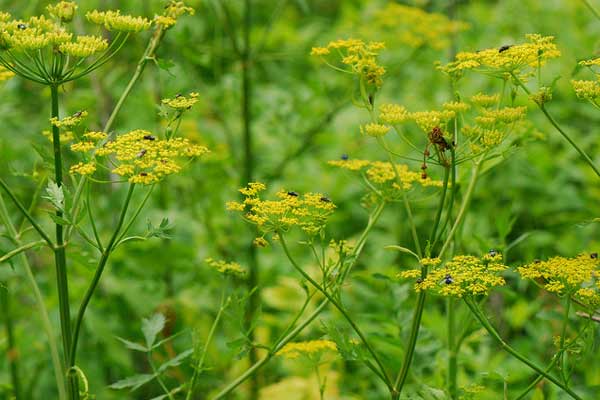Wild Parsnip - Harmful Invasive Plant
Originating in Eurasia, Wild Parsnip is an invasive plant that has spread throughout most of the United States, including some areas in the lower Adirondacks. Sometimes called "Poison Parsnip," it is an herb with aromatic leaves (when crushed), much like its edible Parsnip relative, yet contains photochemicals in its juices that react to sunlight to cause a blistering burn. Learn the key facts to identify and avoid the effects of this harmful weed, and learn control measures to help minimize its spread as an invasive plant.
What Does It Look Like?

Wild Parsnip can survive in a variety of soil conditions yet prefers a combination of full sun and moist soil and can be found growing along roadsides, overgrown fields, waste sites, recently disturbed soil and other areas in the southern Adirondacks.
Key facts for identification:
- Grows 2-5 feet tall
- Has yellow, flat-topped umbel flower clusters
- Has deeply lobed leaves with jagged, saw-toothed edges
- Leaflets grow opposite one another in pairs along the stalk
- Stem is hollow and grooved
- Stem and leaves closely resemble celery
- Blooms June through July
- Prefers areas with full sun
How Is It Harmful?
Chemical compounds in the sap produced by both the Wild Parsnip and Giant Hogweed invasive plants are extremely dangerous to humans. Skin that comes into contact with the sap becomes extremely sensitive to sunlight, resulting in a painful burn that produces severe blisters and scarring. Sap in the eyes can cause blindness. Contact with the broken stem, leaves or seeds causes exposure to the dangerous sap. Often the irritation will be streaked or splattered, indicating the manner in which the plant's juices came into contact with your skin.
Wild Parsnip is an invasive species, originating in Eurasia and not native to the Adirondacks or other areas where it has spread. It threatens native species and should be eradicated when discovered to prevent further spread into the Adirondacks.
How To Avoid It?
Contact with the harmful sap produced by Wild Parsnip usually occurs during mowing or otherwise breaking the plant to expose its juices. Be on the lookout in preferred growth areas for its characteristic yellow flower umbels and other distinguishing features.
Management of invasive species is key to controlling the spread of harmful plants like Wild Parsnip. Individual plants can be uprooted or cut down before seeding occurs to help thwart its spread, but be careful not to expose your skin or eyes to its juices. If you are mowing areas with possible Wild Parsnip growth, be sure to wear protective clothing, and wash thoroughly afterwards. Remember, the phototoxin in the sap reacts with UV light exposure.
What If I Touched It?
If your skin has come into contact with Wild Parsnip sap from the juices of its stem or leaves, WASH the area immediately and thoroughly with soap and water and AVOID ALL SUNLIGHT for 48 hours to lessen the severity of the reaction. FLUSH eyes with water and avoid sunlight if you think you may have gotten the sap in your eye. Remember, the sap contains phototoxins, which are activated by UV light exposure to cause severe burns. It is wise to seek medical attention if you have had exposure to this plant's harmful sap.
Sources:
http://www.nyis.info/index.php?action=invasive_detail&id=61
http://adkinvasives.com/species_of_concern/wild-parsnip/
http://northernwoodlands.org/articles/article/avoiding_rash_decisions_a_guide_to_plants_you_shouldnt_touch
Photo Credit: Joshua Mayer: Wild Parsnip (Pastinaca sativa) ~ Invasive (license)
« Return to Invasives & Harmful Plants Guide